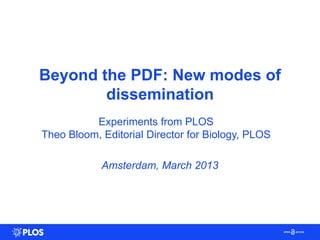Beyond the PDF2 - Amsterdam, March 2013
- 1. Beyond the PDF: New modes of dissemination Experiments from PLOS Theo Bloom, Editorial Director for Biology, PLOS Amsterdam, March 2013
- 2. Take-home / talking points / provocation ŌĆó Trying to fix a big interconnected system - itŌƤs not easy or fast ŌĆó One change at a time brings people along ŌĆó Steps are good if theyŌƤre in the right direction ŌĆó Partner with others wherever it makes sense ŌĆó Experiments are good: adapt to the results 2
- 3. The idealised cycle of research communication Do some science Discuss ideas Write a description Read/use other Share it with peopleŌĆÖs work the world 3
- 4. The real-life cycle is more complicated Do some science Discuss ideas Write a description Read / use other peopleŌĆÖs work Rejection. Try Submit it to another journal a journal Get promoted Do more work as requested Get grants Resubmit Be judged by publications Publication
- 6. The real-life cycle has some big problems Problem 4: poor Problem 1: links from Access to what underlying data and Do some you want to read science methods to write-up and (re) use Discuss ideas Write a description Read / use other peopleŌĆÖs work Rejection. Try Submit it to another journal a journal Get promoted Problem 5: Do more work as requested Problem 3: Problem 2: Get grants Resubmit because of publication venue Be judged by problem 2, repeat as a measure of publications cycles at different publication quality Publication journals; and/or impact publication is delayed
- 7. The real-life cycle has some big problems Problem 4: poor Problem 1: links from Access to what underlying data and Do some you want to read science methods to write-up and (re) use Discuss ideas Write a description Read / use other peopleŌĆÖs work Rejection. Try Submit it to another journal a journal Get promoted Problem 5: Do more work as requested Problem 3: Problem 2: Get grants Resubmit because of publication venue Be judged by problem 2, repeat as a measure of publications cycles at different publication quality Publication journals; and/or impact publication is delayed All subject areas; not assessing ŌĆ×impactŌƤ
- 8. We havenŌƤt ŌĆ×solvedŌƤ problems 1-3 ŌĆó Beyond CC-BY: explore better ways to do openness (metadata, data, reusability); and accessibility ŌĆó Beyond ALMs: make altmetrics optimally useful and encourage wider adoption ŌĆó Beyond PLOS ONE: more formal experiments with peer review this year ŌĆō increase openness; structure reviewer information; portable reviews? ŌĆ” We have made some progress in these areas 8
- 9. Problem 4: poor links from underlying data and methods to write-up Do some science Write a description
- 10. Do some science Write a description Store some of the data somewhereŌĆ”
- 11. Do some science Integrated collection of methods, results, data, metadata Write a narrative Store all of the description that is data somewhere inextricably linked to the data and methods useful and link to publication
- 12. Steps towards better data handling What to do with ŌĆ×homelessŌƤ data? Partnership with Dryad (www.datadryad.org) ŌĆó Unstructured data ŌĆ×packagesŌƤ associated with published articles ŌĆó Freely available - CC0 ŌĆó A unique identifier (DOI) for each package ŌĆó Statistics for access ŌĆó Seamless tying together of article and data Partnership with figshare (www.figshare.org) ŌĆó figshare widget displays Supporting Information files directly in the article ŌĆó search, magnify, download singly or as a package Planning in hand for ŌĆ×data papersŌƤ (www.ploscompbiol.org) ŌĆó Describes reusable dataset to support reuse ŌĆó Publishes associated metadata ŌĆó Ensures valuable data is actionable for reuse ŌĆó Data accessible in a recognized, stable repository
- 13. Can we revolutionize speed? Problem 5: PLOS Currents: Influenza - Inspiration Seeking Lessons in Swine Flu Fight ŌĆ£Another problem is communication. Officials and experts say they have learned a lot about human swine influenza. But relatively little of that information...has been reported and published. Some experts said researchers were waiting to publish in journals, which can take months or longer.ŌĆØ New York Times, August 10th, 2009 Lawrence K. Altman, M.D. 13
- 14. Rapid technical and scope review Authors may revise but can be published almost immediately post-review Content is peer-reviewed, citable, publicly archived, and included in PubMed
- 15. What comes out: flexible (familiar) format
- 16. PLOS Currents as an experiment ŌĆó Swine flu epidemic faded away - then a new one started ŌĆó We said ŌĆ£submissions do not have to be full-length articlesŌĆØ ŌĆō but what did we get? ŌĆó What use-cases make most sense for Currents? ŌĆó Can we try harder with non-traditional article formats? ŌĆō Single findings ŌĆō Negative results ŌĆō Replications ŌĆō Methods and protocols ŌĆó Publish all results with as little delay as possible 16
- 17. Back to issue 1: Access vs. accessibility ŌĆó Readable by machines as well as people ŌĆó Intelligible 17
- 18. Where do people go for information? ŌĆó open review via wiki ŌĆó PLoS Comput Biol article ŌĆ£version of recordŌĆØ ŌĆó A high-quality Wikipedia article that can be edited and updated 18
- 19. Take-home / talking points ŌĆó Trying to fix a big interconnected system - itŌƤs not easy or fast ŌĆó One change at a time brings people along ŌĆó Steps are good if theyŌƤre in the right direction ŌĆó Partner with others wherever it makes sense ŌĆó Experiments are good: adapt to the results ŌĆó We need to work with real people ŌĆō authors, readers ŌĆō as well as with machines 19
- 20. Open Access tbloom@plos.org 20



















